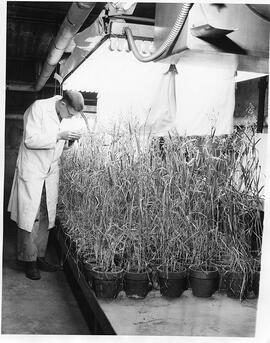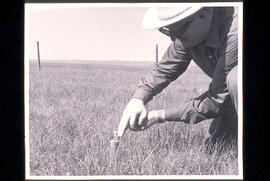Agricultural Research - Field Crops
- A-1990
- Item
- [195-?]
Doug Knott, professor, Crop Science (Field Husbandry) Department, inspecting field crops which are planted in a series of pots; scene is inside a laboratory.
Bio/Historical Note: The Field Husbandry Building was conceived and constructed as a direct result of the fire that destroyed the Engineering Building in 1925. The Department of Field Husbandry, which had moved to Engineering four years earlier, lost its entire seed stock to the blaze. The Engineering Building that rose from the ashes was not, however, to include the Department of Field Husbandry. They were to have their own new and separate structure. Designed by David Brown, the stone clad structure was finished in 1929 at a cost of $260,000 and contained offices, classrooms and laboratories. The building also acted as a screen to mask the brick portion of campus from the buildings around the Bowl. In 1937 an addition, designed by local architect and University lecturer G.J.K. Verbeke, extended the building northward. The School of Medical Science moved into the addition from their cramped quarters in the College Building and stayed until the completion of the Medical College in 1950. Field Husbandry changed its name to Crop Science in 1962 and remained in the building until the College of Agriculture Building was completed in 1991. In 1997 the Department of Anthropology and Archaeology moved into the building, which was renamed accordingly. The Department of Anthropology was amalgamated with the Department of Religious Studies and relocated from the building in 2002; the building was subsequently renamed the Archaeology Building.



